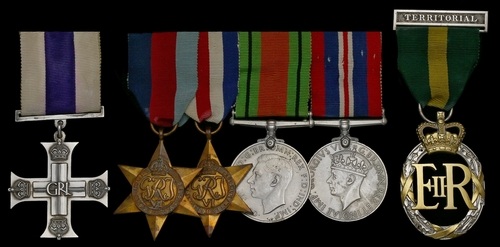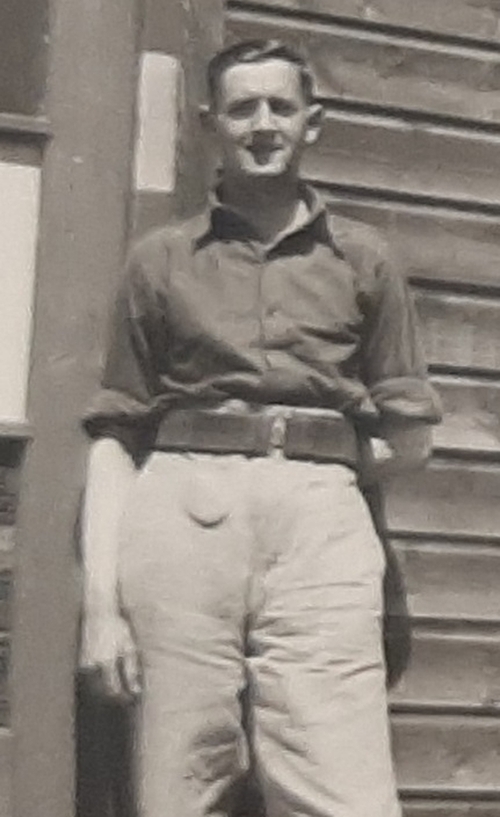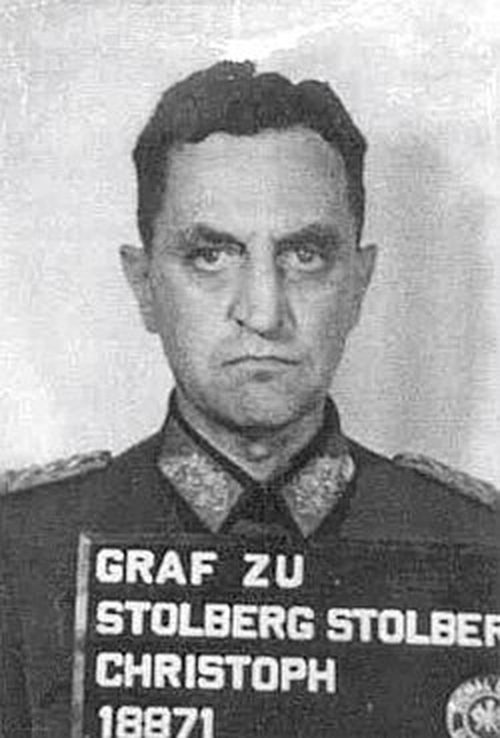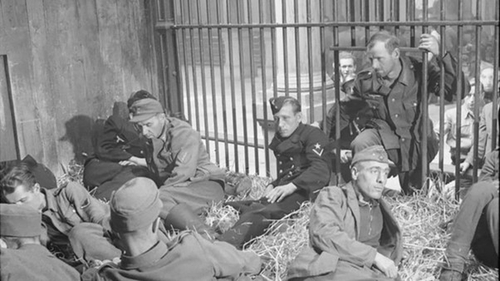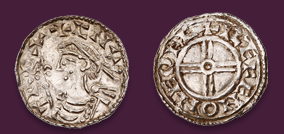Auction: 25002 - Orders, Decorations and Medals
Lot: 138
'The Germans had dug their fortress headquarters deep in a park in the centre of Antwerp and when our forces entered the city the task of neutralising the fortress was given to a company of infantry - only 43 strong - attached to the division. Under the cover of tanks, the Major, a section commander and two men advanced from doorway to doorway until they reached the main road fronting the park. Then a burst of machine-gun fire mowed down the section commander and the two men.
As they dropped, the Major dashed forward, jumped over a wide wire entanglement and landed in a firing bay which led directly to the machine-gun post. Lobbing a hand grenade, the Major gave two bursts with his Sten gun, which jammed.
Taking another chance, the Major dived out of the bay, leapt the wire again, and, doubling across the road, picked up a rifle and grenade from one of the wounded men, and turned and jumped the wire again… Then he threw the grenade and charged the machine-gun post with bayonet fixed. The German sergeant, who with a private, manned the machine-gun, fired his revolver at point-blank range, missed, and then with the bayonet within an inch of his heart, surrendered.
Meanwhile the rest of the platoon had made their way up the street, and under covering fire from tanks, stormed the fortress gate…'
A wartime newspaper report covering the extraordinary actions of Major Tom Maddocks, K.S.L.I.
The outstanding Second World War M.C. group of six awarded to Major T. 'Tom' Maddocks, King's Shropshire Light Infantry, a Company Commander in the 4th Battalion who played a crucial role in the capture of Antwerp in September 1944
In a roller coaster of courageous actions, he and his small force took 300 prisoners, among them General Graf von Stolberg-Stolberg, the region's G.O.C. One of his prisoners was shot dead beside him by misplaced enemy fire and others - owing to a shortage of secure spaces - were temporarily confined to cages in the city's zoo
Military Cross, G.VI.R., the reverse officially dated '1945', in its Royal Mint case of issue; 1939-45 Star; France and Germany Star; Defence and War Medals 1939-45; Efficiency Decoration, E.II.R., Territorial, the reverse officially dated '1961', in its Royal Mint case of issue, sold together with an archive of original archive, good very fine (6)
Provenance:
Tennants, 20 June 2001, when sold by the recipient's sister.
M.C. London Gazette 1 March 1945, the original recommendation - signed off by Montgomery - states:
'On 4 September 1944, 'A' Company, 4th K.S.L.I., commanded by Major Maddocks, was given the task of assaulting the triangular park in Antwerp from the western and southern sides. This park was defended by a considerable barbed wire fence, numerous Tobruk bunkers and concrete defences. The action of this company, led by this officer, resulted in the capture of 300 prisoners, including a General, 30-40 killed and 20 wounded, and was responsible for the rapid clearance of the centre of Antwerp, thus giving us control of the town of Antwerp.
Throughout this action this officer showed remarkable powers of leadership and personal bravery of the highest order. At one period he was crossing the road into the park with his batman, when an enemy machine-gun opened up killing his batman. The machine-gun was 20 yards distant and covered by a barbed wire fence. This officer promptly threw a grenade at the post and got over the wire into the trench system, where he found himself faced with two of the enemy who fired at him and missed. He returned the fire with his Sten gun which promptly jammed.
He then recrossed the wire, seized his dead batman's rifle and grenades and under cover of another grenade recrossed the wire into the trench system where he forced the two enemy to surrender. He then led his two prisoners across the wire under enemy fire which killed one of the two prisoners.
Throughout this action this officer displayed leadership and personal bravery of the highest order.'
Thomas Maddocks was a pre-war member of the 4th Battalion, King's Shropshire Light Infantry (Territorials), in which he was serving as a 2nd Lieutenant on the outbreak of hostilities in September 1939.
But by the time the battalion went into action in the North-West Europe campaign he was serving as a Major and C.O. of 'A' Company.
Heavily laden with equipment, the battalion landed at Courseill-sur-Mer on 14 June 1944 and marched to the village of Cainet, where Maddocks quickly made a name for himself on inventing the 'Tommy Bundle', namely a greatcoat and blanket wrapped in the ground sheet and secured by valise straps.
A week or so later, the battalion was put on readiness for Operation 'Goodwood', in which, in July, it suffered its first casualties, namely four officers and 96 other ranks. And in subsequent fighting in the 'Bocage' those casualties rose at an alarming rate. At length, however, with what might be termed the battle of the bridgehead over, Maddocks and his comrades were next tasked with the advance to the Rhine, through Belgium and Holland.
And the first major nut to be cracked was the vital port of Antwerp. Here, then, Maddocks' moment of glory, his skill, leadership and personal courage culminating in the capture of 300 enemy troops, among them General Graf von Stolberg-Stolberg. The whole had been positioned in the city's central park at Merxem. The regimental history takes up the story:
'Major Tom Maddocks' task of capturing the bunkers was difficult enough without the added restriction denying him the use of mortars lest civilians might be killed or wounded. The park had to be broken into through a thick hedge, heavily wired. The ornamental lake severely restricted manoeuvre and could only be crossed by a single narrow bridge. Besides this the attacking force would be exposed to fire from the enemy in the tall buildings surrounding the park. Maddocks decided to send Lieutenant 'Jenny' Wrenn with No. 8 Platoon along the main roads enclosing the park (the Rubens-lei and especially the Van Eyck-lei) with the task of suppressing all sniper fire.
Maddocks himself led 7 and 9 Platoons and stormed into the park from the south side, supported by covering fire from his troop of three tanks. He then led the way across the narrow ornamental bridge and charged across the remaining hundred yards to the bunkers, his Bren gunners firing from the hip. White flags appeared from the bunkers and the Germans, including General Graf von Stolberg-Stolberg, the G.O.C. Antwerp District, surrendered.'
The same source continues:
'Some 300 prisoners were taken in the park and put in the charge of the Resistance to be confined in the local zoo. Thus, by early evening, two hours after reaching the Central Park, the main German force and its overall commander were safely in the bag.'
That evening, Maddocks shared a 'thick whisky' with a fellow officer, Tim Ellis. The latter later recalled how Maddocks thought for a moment he had captured another senior officer, for another rather grand looking fellow emerged from the bunker hot on von Stolberg's heels. Much to his disappointment, however, it transpired to be a Bandmaster.
The day following his M.C.-winning exploits, Maddock was back in action in mopping up operations, extracting his company from a factory near the city's Albert canal which was being shelled by enemy tanks at point-blank range. The street outside was a sheet off flames, and swept be enemy fire, but he nonetheless led two of his platoons across it. It was also about his time that Maddocks assumed temporary command of the battalion, Lieutenant-Colonel Reeves having been wounded.
As far as is known, Maddocks remained on active service in 4th K.S.L.I. until VE Day. So he would have witnessed much action in Holland, including operations in support of 'Market Garden'; so, too, the award of the V.C. to a member of his 'A' Company, Sergeant George Eardley, who was decorated for his gallantry in October 1944. And thence to Germany in the wake of the Rhine crossing.
He died in Torbay, Devon in 1968, aged 51.
Sold with a quantity of original documentation, comprising the recipient's original Buckingham Palace forwarding letter for the M.C., in the name of 'Major T. Maddocks, M.C., The King's Shropshire Light Infantry'; War Office letter of notification for the award of his Efficiency Decoration, dated 22 September 1961; a letter from Lieutenant-General M.R. Robinson, D.S.O., with a typed copy of the M.C. citation, dated 13 July 1945; several wartime photographs, the above quoted newspaper cutting and a file of comprehensive research.
For his miniature dress medals, please see Lot 157.
Subject to 20% VAT on Buyer’s Premium. For more information please view Terms and Conditions for Buyers.
Sold for
£1,500
Starting price
£1200

